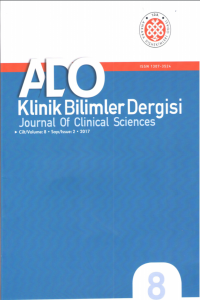Submandibular Tükürük Bezi Taşı
Sialolithiasis, tükrük bezi, submandibular, cerrahi eksizyon
Submandibular Gland Sialolithiasis
Sialolithiasis, salivary gland, submandibular, surgical excision,
___
- Seifert G: Diseases of the Salivary Glands. Berlin, Springer-Verlag, 2000 p:224-228.
- Ashby RA. The chemistry of sialoliths: stones and their homes. In: Norman JED, McGurk M, eds. Color Atlas and Text of the Salivary Glands: Di- seases, Disorders,and Surgery. London, England: Mosby-Wolfe; 1995 p;122-125.
- Yamamoto H, Sakae T, Takagi M, Otake S. Scan- ning electron microscopic and X-ray microdiffrac- tometeric studies on sialolith-crystals in human submandibular glands. Acta Pathol. Jpn. 34:47- 53, 1984.
- Anneroth G, Eneroth CM, Isacsson G. Crystalline structure of salivary calculi: a microradiographic and microdiffractometric study. J. Oral Pathol. 4:266-272, 1975.
- Azaz B, Regev E, Casap N, Chicin R. Sialolithec- tomy done with a CO2 laser: Clinical and scintig- raphic results. J. Oral Maxillofac. Surg. 54:685, 1996.
- Berçin S, Kutluhan A, Yurttaş V, Kanmaz A. Sub- mandibular Siyalolityazise Yaklaşımımız. Yeni Tıp Derg. 26: 16-19, 2009.
- Knigsberger R, Feyh J, Goetz N, Kastenbauer E. Endoscopicallycontrolled electrohydraulic intra- corporeal shock wave lithotripsy (EISL) of salivary stones. J. Otolaryngol. 22:12, 1993.
- Harring JI. Diagnosing salivary stones. JADA.122:75, 1991.
- Lustman J, Rogev E, Melamed Y. Sialolithiasis. A survey on 245 patients : A review of the literatu- re. Int. J. Oral Maxillofac. Surg. 19:135, 1990.
- Yoshizaki T, Maruyama Y, Motoi T, Wakasa R, Frukava M. Clinical evaluation of extracorporeal schock wave lithotripsy for salivary stones. Ann. Otol. Rhinol. Laringol. 105:63, 1996.
- Tro H, Schneider HT, Fodra C, Waitz C, Nits- che N, Heinritz HH, Renninger J, Fil C. Shock wave lithotripsy of salivary duct stones. Lacet. 339:1333, 1992.
- Tro H, Waitz G, Nitsche N, Renninger J, Schne- ider T. Extracorporeal piezoelectric shock wave lithotripsy of salivary gland stones. Laryngosco- pe. 102:492, 1992.
- ISSN: 1307-3540
- Yayın Aralığı: Yılda 3 Sayı
- Başlangıç: 2006
- Yayıncı: Ankara Diş Hekimleri Odası
Dental Travmalarda Ortodontik Yaklaşım
İldem ÜSTÜNKOL, Bahar Güçiz DOĞAN, Saadet GÖKALP
Geniş Periapikal Lezyonlu Dişlerin Cerrahi Olmayan Yöntemle Tedavisi
Mine BOZKURT, Canan DAĞ, Mustafa DAĞ, Nurhan ÖZALP
Submandibular Tükürük Bezi Taşı
Cem ÜNGÖR, Sibel TURALI, Hakan KURT
Vertikal Kök Kırıkları: Klinik ve Radyografik Bulgular, Risk Faktörleri
Mandibular Odontomanın Cerrahi Olarak Uzaklaştırılması
Pınar ÇERVATOĞLU ULUS, Hüseyin ASLANTÜRK, Erdal ERDEM
Pemfigus Vulgaris, Serbest Dişeti Grefti ve İmplant Uygulaması
Emine Elif ALAADDİNOGLU, Bahar Füsun ODUNCUOĞLU
Ezgi KARAÇELEBİ, Mustafa ÖZTÜRK
Kronik Böbrek Yetmezliğine Bağlı Renal Osteodistrofide Radyografik Bulgular: Bir Olgu Sunumu
